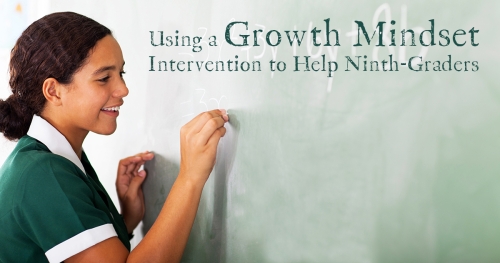Analysis of the Growth Mindset Study Data

Overview
The transition into high school is a volatile time for adolescents and a precarious point in the course of their education. Students who successfully navigate this transition and pass their ninth-grade classes are far more likely to graduate from high school with their peers and attend college than those who fail courses in the ninth grade.
The growing awareness of the importance of the first year of high school for future success has prompted schools and districts across the country to develop interventions designed for ninth-graders. This study focuses on one such program: a “growth mindset” intervention. The intervention consists a set of two self-administered online modules (25 minutes each) designed to communicate the message that the brain can grow “stronger” (that is, more intelligent). This approach aims to increase students’ desire to take on challenges and improve their persistence.
A growing body of studies has evaluated various growth mindset interventions; in several studies, interventions reduced students’ belief that intelligence is a fixed trait that cannot be changed and helped them earn higher grades. But much remains to be learned about how the intervention operates at a large scale in a nationally representative sample of schools, and how school context and student characteristics influence the effectiveness of the program. The Growth Mindset Study aims to address these issues.
Additional Project Details
Agenda, Scope, and Goals
The Growth Mindset Study uses a student-level random assignment design to assess the effects of a growth mindset intervention on the academic performances of ninth-graders in a nationally representative sample of 76 schools. The study was designed by an interdisciplinary team of psychologists, sociologists, education researchers, statisticians, and economists at the University of Texas at Austin, and other universities around the United States, with the support of the Mindset Scholars Network and the Center for Advanced Study in the Behavioral Sciences.
The MDRC team is using administrative data to conduct an independent evaluation of the growth mindset intervention. The analysis focuses on the following questions:
-
What is the average effect of the growth mindset intervention on the grade point average (GPA) of ninth-grade students in a nationally representative sample of U.S. public high schools?
-
What is the average effect of the growth mindset intervention on the GPA of low-performing ninth-graders in a nationally representative sample of U.S. public high schools?
-
Does the effect of the intervention on low-performing ninth-graders vary across schools?
-
Do school-level factors explain the variability in the effect of the intervention on low-performing ninth-graders?
Findings will be reported in a policy brief, and all data used for the analyses will be made available as a restricted use data file. With the support of the university team and the Mindset Scholars Network, MDRC aims to provide the field with independent, robust, and transparent information about the effectiveness of the growth mindset intervention when it is implemented on a large scale in a nationally representative sample.
Design, Sites, and Data Sources
The developers of this growth mindset intervention worked with ICF International, a data collection and research firm, to recruit a nationally representative sample of 76 high schools; conduct student-level random assignment; and, with school staff members, deliver the online sessions to the ninth-graders in these schools. As students logged in, they were randomly assigned to receive either two 25-minute growth mindset sessions or alternative sessions as described below.
Students assigned to the growth mindset intervention (1) were presented with information about neural plasticity that emphasized how brain functions can improve when one confronts new challenges and practices more difficult ways of thinking, and (2) completed writing exercises designed to help students understand and internalize the intervention message by applying the message to their own lives and restating the message for future students.
Students assigned to the alternative condition also read a brief article about the brain and completed a written assignment that involved answering reflective questions, but instead of learning about the brain’s malleability, they learned about basic brain functions and their locations. The experimental conditions were designed to look similar so that students’ instructors would remain blind to their condition assignment, and to discourage students from comparing their materials.
Additionally, ICF collected multiple sources of data on the local school context (math teachers’ levels of experience, attitudes and expectations, and instructional practices); student and parent backgrounds; student experiences, attitudes, and expectations; and student transcript data, including available course grades and test scores.
Featured Work
An Independent Evaluation of the National Study of Learning Mindsets







